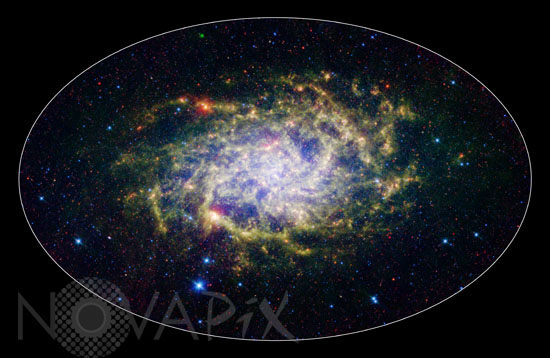Photo Agency - Astronomy - Space - Nature

Spiral galaxy M33 seen in infrared
author: NASA/JPL-Caltech/ Univ.of Ariz./Novapix
reference: a-gax05-98019
Image Size 300 DPI: 36 * 23 cm
Also known as M33 or NGC 598, the Triangulum Galaxy is part of the Local Group of galaxies, which includes the Andromeda Galaxy (M31) and our galaxy, the Milky Way. M33 is over thirty thousand light-years across, and more than two million light-years away. Viewed here with Spitzer's infrared eyes, this elegant spiral galaxy sparkles with color and detail. Stars appear as glistening blue gems (several of which are actually foreground stars in our own galaxy), while dust rich in organic molecules glows green. The diffuse orange-red glowing areas indicate star-forming regions, while small red flecks outside the spiral disk of M33 are most likely distant background galaxies. But not only is this new image beautiful, it also shows M33 to be surprising large—bigger than its visible-light appearance would suggest. With its ability to detect cold, dark dust, Spitzer can see emission from cooler material well beyond the visible range of M33's disk. Exactly how this cold material moved outward from the galaxy is still a mystery, but winds from giant stars or supernovas may be responsible.
This is a three-color composite image showing infrared observations from two of Spitzer instruments. Blue represents combined 3.6- and 4.5-micron light and green shows light of 8 microns, both captured by Spitzer's infrared array camera. Red is 24-micron light detected by Spitzer's multiband imaging photometer.
Contact : Stéphane Aubin +33-(0)9-51-26-53-76
© Novapix - All rights reserved


